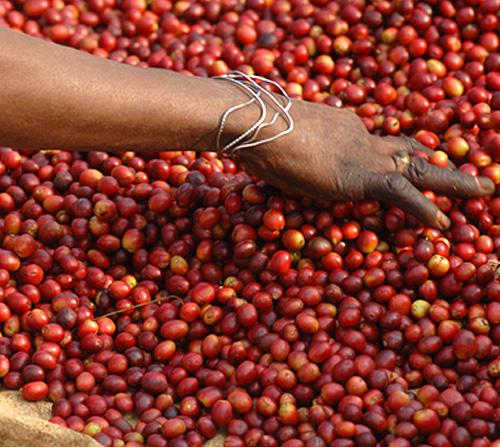About Tanzania Mbilidno Peaberry microlot
Arrived late June 2023 in grainpro bags.
Tanzania Kilimanjaro Peaberry, is grown in one of the most unique micro-climates in the world, near Mount Kilimanjaro. For those who may not be familiar with the peaberry, it is a common seed mutation. The bean develops into an elongated pearl shape, forming just a single seed or coffee bean, as opposed to typical flat beans. Most coffee cherries have two opposing flat seeds at their center but the peaberry has but one. Generally, about 3 percent of a coffee crop contains peaberry, and as in this case, they are separated from from flat beans. Peaberries have different roasting and flavor characteristics; due to their shape they roll easily in drum roasters (Behmor, Hottop, Genecafe) and are less prone to scorching; But in some hot air roasters they may take longer to be lifted by the forced air as the shape is more aerodynamic and have less surface area. Peaberries seem to have a somewhat higher flavor concentration that comparable flat beans.

The farmers here delivery red cherry usually within a specific window during the day of 2pm-6pm where the coffee is pulped that day at the coop level and graded..The best coffees are kept separate and fermented for 24 to 36 hours before being washed in canals. After this first wash, coffee is soaked for another 8-12 hours with fresh water changed every 3 hours. Sometimes they are given a 8-12 hour post-washing soak before they are dried. Coffee is then dried on raised beds for 7 to 10 days.
- Country: Tanzania
- Farm: Mbilidino
- Varieties: Blue Mountain, Bourbon, Kilimanjaro, and Luwiro
- Elevation: 1870 meters
- Processing: Washed
- Drying: Sun dried on African raised beds
- Harvest periods: South Tanzania: May-September, North Tanzania: July-November
Tanzania
With its relatively close proximity to Ethiopia, and its shared border with Kenya, some of Tanzania's population has had a long history and culture relationship with coffee, namely the Haya people, for whom the plant was not used so much as a beverage as a chewed fruit. Coffee (probably Robusta) was grown for this domestic purpose until German colonists essentially mandated that farmers grow Arabica coffee as a cash crop, spreading the plants' reach within the country and developing the industry around Mount Kilimanjaro.
Germany lost control of the colony to the British after the First World War, and the British attempted to develop a more efficient and profitable coffee industry along the lines of Kenya's. Cooperatives of smallholder farmers started to organize in the 1920s to try to improve market access, but it was many years before Tanzanian coffees really caught on internationally.
In 1964, after both countries achieved independence from Britain, Tanganyika and Zanzibar were combined to establish the Republic of Tanzania - hence the country's name, Tan/Zania. Growers attempted aggressive growth in the 1970s but had difficulty increasing production. The 1990s saw efforts to reform and privatize coffee exports, allowing growers to sell more directly. Today, in most of the Western world, Tanzanian coffees are famous primarily as separated-out peaberry lots.
The majority of the Tanzania coffee is bought by Japanese roasters, who prize bean-size uniformity and see peaberries as being an undesirable defect. For this reason, the peaberries are often unsold to the Japanese market, and are the majority of what is available to Western buyers. Some swear by peaberries having a degree of flavor potency that normal flat beans lack, and others can't tell the difference. They do tend to be slightly pricier on account of both their more limited quantity (since peaberries occur in a smaller percentage of coffee overall) and the labor involved in sorting them out.

Cup Characteristics: Very sweet aromatics suggestive of maple syrup. Flavors of prune, golden raisin. Complex apple (malic) acidity and nice clean, sweet finish.
Roasting Notes: Can be roasted successfully through most ranges but best approaching full city or terminating the roast just at the outset of second crack. In hot air roasters use a little less than you would of flat beans. In drum or drum-type roasters these beans will roll around nicely and produce an even roast. With a Behmor try P3.

